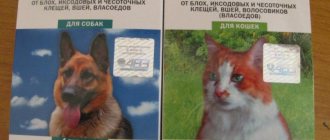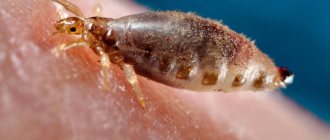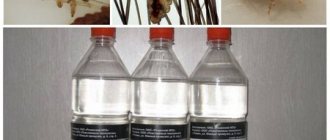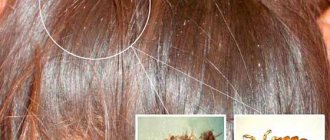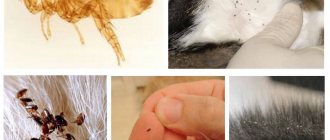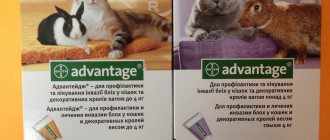Drops "Bars" against lice, fleas, mosquitoes and ticks are a Russian development. When creating this drug, the latest scientific advances in the fight against blood-sucking insects were used. In addition, numerous wishes and reviews were taken into account that came from pet owners who used similar drops. Today, thanks to Bars drops, pet owners can forever save them from the pain and suffering that bloodsuckers cause. The louse is a dangerous insect that carries fatal diseases and destroys the skin of cats and dogs. The drug is dispensed freely, without a doctor's prescription. You can purchase it at any veterinary pharmacy or on a specialized website. You should beware of fakes; genuine drops are sold only in certified retail outlets. The drug is accompanied by printed instructions.
Composition of drops "Bars"
This medicine belongs to the category of insectoacaricidal drugs. It has pronounced activity against the larval and mature stages of development of fleas, lice, lice, mosquitoes, cheyletiella, sarcoptic and ixodid ticks that parasitize dogs and cats. The drops contain several complementary components. The impact on parasites occurs in a complex manner, which ensures their guaranteed destruction at all stages of development.
The developers of Bars drops created it from the following ingredients:
- Fipronil. This substance is a powerful insecticide with a wide spectrum of action. Fipronil has undergone many years of successful testing in agriculture, where, thanks to it, numerous pests have been destroyed without consequences for animals. The substance spreads over the skin without penetrating the circulatory system. Causes damage to the nervous system of parasites without affecting their host. The smell of fipronil is so strong that lice, fleas and mosquitoes avoid it. This helps prevent secondary infection of the animal.
- Diflubenzuron. It disrupts the process of chitin production in bloodsuckers, stopping their molting and reproduction function. Parasitic individuals lose the ability to reproduce and gradually die themselves. Bloodsucker eggs die when detached from the animal's skin.
- Dicarboximide. This substance is an amplifier of the action of the active components of the drops. At the same time, it reduces the degree of toxicity of the components to the animal’s body. The concentration of dicarboximide is adjusted to tenths of a percent. This gives guaranteed confidence that animals will not experience fatal intoxication after using Bars drops.
The components of the drug tend to linger in the tissues of the skin without entering the systemic bloodstream. Without causing harm to the animal, they create therapeutic and preventive effects on the pet’s body.
Bars drops against fleas and ticks
Dosage form: solution for external use. The drug is produced in two modifications: Bars drops against fleas and ticks for cats and Bars drops against fleas and ticks for dogs.
Bars drops against fleas and ticks for cats contain fipronil - 10 mg/ml, diflubenzuron - 1 mg/ml and dicarboximide (MGK-264) - 1 mg/ml as active ingredients, and isopropyl alcohol - 50 mg/ml as excipients. ml, polyvinylpyrrolidone – 30 mg/ml, Tween-80 – 30 mg/ml, nolyethylene glycol 400 – up to 1 ml.
Bars drops against fleas and ticks for dogs contain fipronil - 50 mg/ml, diflubenzuron - 1 mg/ml and dicarboximide (MGK-264) - 5 mg/ml as active ingredients, and isopropyl alcohol - 50 mg/ml as excipients. ml, polyvinylpyrrolidone – 30 mg/ml, Tween-80 – 30 mg/ml, polyethylene glycol 400 – up to 1 ml. In appearance, the drug is a transparent oily liquid from light yellow to yellow.
The drug is produced packaged but 0.3; 0.6; 1.0; 1.4; 2.8; 4.2 and 5.0 ml in polymer dropper bottles, dropper pipettes, dropper tubes or tubes, which are packaged in 1, 2, 3, 4 or 7 pieces in cardboard packs, as well as in blisters and sachets made of combined materials . Each consumer package is accompanied by instructions for use of the drug.
The shelf life of the medicinal product, subject to storage conditions, is 2 years from the date of production. It is prohibited to use the medicine after the expiration date.
Store the medicinal product in the manufacturer's sealed packaging, protected from light and moisture, separate from food and feed, at a temperature from 0°C to 30°C.
Drops should be stored out of the reach of children. Unused medicinal product is disposed of in accordance with legal requirements.
II. Pharmacological properties of Bars drops against fleas and ticks belong to combined insectoacaricidal drugs.
The drug has pronounced activity against the larval and mature phases of development of fleas, lice, lice, heilstiella, ixodid and sarcoptic ticks that parasitize dogs and cats.
The mechanism of action included in the drug fipronil is to block GABA-dependent ectoparasite receptors, disrupt the transmission of nerve impulses, which leads to paralysis and death of ectoparasites.
Diflubenzuron , by inhibiting the synthesis of chitin in parasites, disrupts the process of molting, oviposition and hatching of larvae from eggs, which leads to a cessation of population replenishment. Dicarboximide is a synergist and is used with insecticides to increase their activity.
It stops microsomal detoxification of the insecticide, increasing its toxicity to the parasite.
After skin application (Spot-on) of Bars drops, the active substances included in their composition are evenly distributed over the surface of the body, without being absorbed into the systemic bloodstream, accumulate in the epidermis, hair follicles and sebaceous glands of the animal’s body and have a long-term contact insectoacaricidal effect and protect the animal from fleas and ticks.
In terms of the degree of impact on the body, Bars drops are classified as moderately hazardous substances (hazard class 3 according to GOST 12.1.007-76), in recommended doses they do not have a resorptive-toxic, locally irritating or sensitizing effect; Causes irritation upon contact with eyes. The drug is toxic to rabbits, as well as fish and other aquatic organisms.
III. Procedure for using Bars drops against fleas and ticks is prescribed to dogs and cats from 8 weeks of age for the treatment and prevention of entomosis (lice, fleas, lice), sarcoptic mange, notoedrosis, otodectosis, cheyletiellosis, and ixodid ticks.
A contraindication for use is the increased individual sensitivity of the animal to the components of the drug. Patients with infectious diseases, weakened and convalescent animals, pregnant and lactating females, as well as puppies and kittens under 8 weeks of age and dogs weighing less than 2 kg cannot be treated.
Bars drops against fleas and ticks are used once by drip application to dry, intact skin. The protective effect of the drug lasts for 1-2 months.
Having parted the fur, apply drops to dry, intact skin at several points in the back between the shoulder blades or in the neck at the base of the skull (in places inaccessible to licking by animals).
Taking into account the type and weight of the animal being treated, a package of the required volume or a combination thereof is selected and the drug is used in the doses indicated in the table:
| Animal type and weight | Volume of “Bars” drops in a pipette, ml | Dose, ml per animal | Number of pipettes for processing | |
| Dogs | appropriate volume | volume 1.4 ml | ||
| 2-10 kg | 1,4 | 1,4 | 1 | |
| 10-20 kg | 2,8 | 2,8 | 1 | 2 |
| 20-30 kg | 4,2 | 4,2 | 1 | 3 |
| more than 30 kg | 5 | 5-10 | 1-2 | 4-7 |
| Cats | ||||
| up to 1 kg | 1 | 0.3 (10 drops) | 1 | |
| 1-3 kg | 1 | 0.6 (20 drops) | 1 | |
| over 3 kg | 1 | 1,0 | 1 |
When treating large dogs (over 30 kg), Bars drops against fleas and ticks are dosed at the rate of 0.1 ml/kg, using pipettes of different volumes.
Repeated treatments of animals are carried out according to indications, but not more than once a month.
In order to prevent re-infestation with fleas, the animals' bedding is replaced or the floors of the premises are treated with any insecticidal agent in accordance with the instructions for its use.
To destroy ixodid ticks on the body of an animal, 1 drop of the drug is applied to the tick and the place of its attachment to the skin. If within 20-30 minutes the tick does not fall off spontaneously, then it is carefully pulled out of the body with tweezers and destroyed.
Do not wash or bathe the animal for 3 days before and after treatment, and do not apply the drug to wet or damaged skin.
When treating otodectosis, the auricles and ear canal are first cleaned of earwax, exudate and scabs, then 4-6 drops of the drug are instilled into each ear.
To distribute the drug evenly, the auricle is folded lengthwise and its base is lightly massaged. The remainder of the drug in the pipette is applied to the animal’s skin between the shoulder blades.
In advanced cases of otodectosis, complicated by otitis, antibacterial and anti-inflammatory drugs are prescribed and auricular application of drops is repeated after 7-10 days.
The drug must be administered into both ears, even in cases where only one of them is affected by otodectosis. To prevent splashing of the drug (if the animal shakes its head), the animal’s head should be fixed for several minutes.
Bars drops against fleas and ticks should not be used auricularly if the eardrum is perforated.
In case of overdose or ingestion, the animal may experience excessive salivation, muscle tremors, and vomiting. In this case, the drug is thoroughly washed off with water and detergent and the animal is prescribed symptomatic therapy.
No specific effects of the drug during its first use and discontinuation were identified.
When repeated use, you should avoid violating the drug use regimen, as this may lead to a decrease in effectiveness. If the next treatment is missed, it is carried out in the same dose according to the same scheme.
As a rule, there are no side effects or complications when using Bars drops against fleas and ticks in accordance with these instructions. If the animal's individual sensitivity to the components of the drug increases and complications occur (excessive salivation, lacrimation, vomiting), treatment is stopped and the drug is washed off with water and detergent.
There is no information about the incompatibility of the drug with drugs from other pharmacological groups and feed additives.
The medicinal product is not intended for use in productive animals.
IV.
Personal preventive measures When working with Bars drops against fleas and ticks, you should follow the general rules of personal hygiene and safety precautions provided for when working with medications. While working with the medicinal product, you are not allowed to smoke, drink or eat. When finished, wash your hands thoroughly with warm water and detergent.
Do not pet the animal or allow it near small children until the area where the drug is applied is completely dry (within 24 hours after treatment).
People with hypersensitivity to the components of the drug should avoid direct contact with the drops. If allergic reactions occur or if the drug accidentally enters the human body, you should immediately contact a medical facility (bring with you the instructions for use of the drug or the label).
Empty drug containers must not be used for household purposes; they must be disposed of with household waste.
Organization-, 141305, Russia, Moscow region, Sergiev Posad, st. Central, 1. The instructions were developed by NVC Agrovetzashchita LLC, 129329, Russia, Moscow, Kolskaya st., 1, building 1.
Interesting
Source: https://veterinarka.ru/vetmedicaments/bars-kapli-insekto-akaricidnye.html
Indications for use
Bars solution for external use is used for the treatment and prevention of parasites in cats and dogs. The thoughtful composition of the medicine guarantees that pets will be freed from parasites without undesirable consequences.
Fipronil insecticide - chemical formula.
Drops are used to detect the following diseases in animals:
- sarcoptic mange;
- otodectosis;
- notoedrosis;
- entomoses;
- cheyletiellosis;
- damage by ixodid ticks.
The drug is available in the form of syringes and tubes with a capacity of 0.3 to 5 ml. The concentration of the solution varies depending on what type of animal it is intended for. So, for dogs the concentration is 5 times higher than for cats. This must be taken into account when purchasing the drug.
When purchasing a product, you must check the originality of its packaging. If it shows signs of being made in a handicraft way, then it is better to refuse the purchase. Each product must be accompanied by documentation with a barcode. All letters and lines must be clear and readable. If you have any suspicions about the origin of a product, it is better to refrain from purchasing it.
Contraindications for use
The solution is intended exclusively for the treatment and prevention of infections by blood-sucking insects in domestic dogs and cats. The medicine cannot be used to combat parasites in other animals kept in the household. Bars parasite drops may be ineffective or fatally toxic when used on nutria, rabbits, hamsters and chinchillas. The immunity of these animals is not ready to be exposed to the components of these drops.
As for dogs and cats, the drug cannot be used in the following cases:
- if your pet is hypersensitive or intolerant to the components of the solution;
- for small animals (adult cats up to 500 g and dogs up to 1000 g);
- individuals who have suffered serious illnesses, operations and are at the stage of treatment and rehabilitation;
- pregnant females at any stage of gestation;
- pets during lactation, regardless of the duration and volume of feeding;
- sick animals suffering from diseases of internal organs;
- pets who have skin lesions, wounds or areas of suppuration;
- puppies up to 2 months old and kittens up to 3 months old.
The medicine must be used carefully to prevent it from getting into the eyes or digestive system.
Snow leopard: description
The animal, which lives high in the mountains of Central Asia, is also called the snow leopard or snow leopard. The name snow leopard comes from Turkic hunters, and was borrowed by Russian merchants back in the 17th century. Only 100 years later did Europeans learn about the existence of this beast. This happened in 1761, when Georges Buffon presented a drawing of this animal with a note that the snow leopard was trained in order to participate in the hunt. It was also indicated here that the animal is found in Persia.
In 1775, a scientific description of the snow leopard was published, presented by the scientist naturalist Johann Schreber. After this, for many centuries, the snow leopard was studied by many zoologists and travelers, including Nikolai Przhevalsky. According to some paleogeneticists, this animal belongs to an ancient species that appeared on planet Earth almost one and a half million years ago.
Appearance
The snow leopard is an impressively sized cat, somewhat reminiscent of a leopard, but not as large in size and more squat. There are a number of other signs that allow you to distinguish a leopard from a leopard: the snow leopard’s tail reaches ¾ of the body length, and the coat is dotted with patterns in the form of rosettes and spots. Adult snow leopards grow up to 2 and a half meters in length, including their tail. The height of the predator at the withers reaches 60 centimeters. Males are heavier, about 55 kg, compared to females, whose weight is no more than 40 kilograms. The head of this animal is round and not large, with the same round and short ears. There are no tufts on the ears, like lynxes, and in winter, due to the thick fur, the ears are practically invisible.
The predator has quite expressive eyes, the color of which matches the color of the fur and whiskers, up to 10 cm long. The legs of the snow leopard are relatively short, and the paws are wide and massive, armed with retractable claws. The tracks left by this predator are round in shape and without claw marks. The tail looks somewhat thicker than it actually is due to the high and thick fur. Thanks to its long tail, the predator can easily maintain its balance while moving in such difficult mountain conditions.
Interesting to know! Snow leopard fur is incredibly thick and soft to the touch. Thanks to this quality of wool, the animal manages to survive in such harsh conditions. The density of the coat is the same as that of ordinary cats, which is considered very unique.
The color of the coat in the back area, as well as the upper areas of the sides, is distinguished by a light gray shade, turning more into white, while the color of the belly and thick parts of the limbs, as well as the lower areas of the sides, is lighter. The unique pattern consists of large round rosettes, as well as solid spots, also round, in black or dark gray. The smallest spots are located on the head of the predator, and larger ones adorn the neck and legs. Closer to the back of the back, the spots seem to merge and form peculiar stripes located along the back. The second half of the tail is characterized by the fact that the spots also merge and form a wide, incomplete ring, while the tip of the tail is always black.
The animal's winter coat has a grayish tint with a smoky touch, which is more typical on the back and sides. Sometimes there is a slight yellowish tint. Thanks to this body color, the snow leopard is easily camouflaged among snow, ice and rocks. With the arrival of summer, the snow leopard's fur color becomes almost white, so the dark spots become more noticeable.
Adult individuals, and especially older ones, do not have such bright fur as their younger relatives.
Behavior and lifestyle
This is an animal that is tied to territory and prefers to lead a solitary lifestyle. Groups of animals can only be seen when females are engaged in feeding and raising their offspring. Each adult individual has its own section of territory, ranging from 15 to 200 square km. The border of each individual is marked with a special secret, although snow leopards do not try to defend it in fights. The snow leopard goes hunting either early in the morning or at dusk and rarely during the daytime. These animals, living in the Himalayas, hunt exclusively in twilight conditions.
During the daytime, the cat rests on the rocks, and it can use the same den for many years. For a den, the snow leopard looks for suitable places, using rock crevices or caves, as well as rocky placers, preferring places located under overhanging stone slabs. There is evidence that some hunters have seen snow leopards in the Kyrgyz Alatau, which have chosen the nests of black vultures.
Interesting moment! The animal regularly walks around its territory, appearing in pastures or camps of wild ungulates, while adhering to the same route. As a rule, the snow leopard trail runs along a mountain ridge or along a river or mountain stream.
Since the territory controlled by the predator is quite large, it takes several days to walk around it. Therefore, a snow leopard appears at one point quite rarely. In addition, due to deep and loose snow, the animal cannot move quickly. Because of this, the snow leopard always prefers to stick to the same route.
SNOW LEOPARD IRBIS - INTERESTING FACTS
How long do snow leopards live?
Living in natural conditions, the snow leopard lives on average about 13 years. If an animal is kept in artificial conditions, then its life expectancy is almost 2 times longer. In zoological parks, snow leopards live for about 21 years, although there is a known case where a female snow leopard lived in captivity for 28 years.
Natural habitats
The habitat of the snow leopard extends exclusively to the mountainous regions of Central and South Asia, the area of which is about 1.23 million square kilometers. Therefore, the snow leopard can be found in the following countries:
- In Russia and Mongolia.
- In Kyrgyzstan and Kazakhstan.
- In Uzbekistan and Tajikistan.
- In Pakistan and Nepal.
- In China and Afghanistan.
- In India, Myanmar and Bhutan.
If you look at the geographical distribution of the habitats of this predator, then the habitat begins in the east of Afghanistan, as well as within the Syr Darya and passes through the Altai, Tannu-Ola, Sayan Mountains, crossing the Pamirs, Tien Shan, Himalayas, Kashmir, etc. In Tibet, the snow leopard lives up to the northern borders of Altushan, and in Mongolia - within the Mongolian-Gobi Altai.
Important fact! Russia is home to no more than 3 percent of the total number of these predators, which are distributed over an area of about 60 thousand square kilometers. The snow leopard in Russia represents the northern and northwestern boundaries of the snow leopard's habitat.
The snow leopard prefers high mountains and eternal snow, choosing to live in areas located on open plateaus, on gentle or steep slopes, as well as in small valleys covered with alpine vegetation, as well as with piles of stones and rocky gorges. Often the snow leopard can be found on flatter areas, with bushes and rocky terrain, where the predator can hide without problems. These animals are more common on the border located above forested areas, although from time to time they also appear in forested areas, especially in winter.
What does it eat?
The snow leopard can attack prey that is three times heavier than itself and easily deals with it. In the wild, this predator hunts the following ungulates:
- On horned and Siberian mountain goats.
- For argali.
- On blue rams.
- For takins and tara.
- On argali and gorals.
- For musk deer and deer.
- For serow and roe deer.
- For wild boars and deer.
With a shortage of wild ungulates, the snow leopard begins to hunt smaller animals such as ground squirrels and pikas, as well as birds such as pheasants, snowcocks and chukars. If necessary, this predator can easily cope with a brown bear, and can also hunt domestic animals such as goats, sheep, horses, etc.
Interesting to know! An adult animal can eat up to 3 kg of meat at one time. With the onset of summer, the predator begins to consume various grasses or young shoots. A predator needs fresh greens to improve the functioning of the digestive system; moreover, this is how predators replenish their bodies with vitamins and minerals.
As a rule, this animal prefers to hunt alone, hiding not far from watering places, salt licks and trails. The snow leopard pounces on its prey from above, from the rocks, or quietly creeps as close as possible.
Closer to autumn, and also with the onset of winter, the female goes hunting with her offspring. The predator attacks its potential prey from a distance of several jumps. If the attack is unsuccessful and the victim manages to escape, the snow leopard never pursues it for more than 3 hundred meters.
As a rule, the snow leopard grabs the animal by the throat, after which it strangles and breaks the neck. After this, he drags the animal’s carcass to a safe shelter where he can eat in peace. Having eaten, the predator can abandon the prey, or it can stay next to it, driving away everyone who wants to dine in the same way.
Reproduction and offspring
It is very difficult to study the life activities of the snow leopard in natural conditions. The fact is that the density of these predators is quite low, and, moreover, the living conditions of these animals do not allow them to fully monitor their life cycles. In this regard, even today researchers do not have all the information about these animals, including some aspects of their reproductive capabilities. The breeding season for predators begins with the arrival of spring. During this period, the males begin to make some sounds that resemble a loud bass meow.
The female does not mate every year, but approximately once every 2 years. Pregnancy lasts from 3 to 4 months. The female sets up her den in the most inaccessible places. After mating, the male leaves the female, entrusting all the care of feeding and raising the future offspring to her. Offspring appear in April/May/June, depending on natural conditions.
Important fact! As a rule, a female gives birth to no more than 3 kittens, although there is information that there can be up to 7 cubs in a litter, although this happens quite rarely. The kittens that are born are blind, helpless, and their body is covered with thick fur, brownish in color, with solid spots, dark in color. The length of newborns can be up to 30 cm, with a weight of about 0.5 kilograms. After about a week or a little more, their eyes open and they begin to see. However, only after a couple of months they begin to leave the den, crawling out. From this moment on, meat begins to appear in their diet, and not just milk.
After a month, the kittens follow their mother completely independently, and already at six months they take part in the hunt. From this period, the juveniles begin to learn the basics of hunting, so they all watch for the prey together, but the decisive throw remains with the mother. The offspring will be fully independent only a year later, next spring. Individuals become sexually mature no earlier than after 3 or 4 years of life.
Natural enemies
The snow leopard has no natural enemies other than humans, since this predator lives in places inaccessible to other predators. In addition, the snow leopard has no competitors and is at the top of the food pyramid. Thanks to such isolation, the animal is protected from incredible enemies, including humans.
Pharmacological properties
The liquid does not penetrate the systemic bloodstream, spreading over the animal’s skin. Active components accumulate in the sebaceous glands, skin cells and hair follicles. This provides long-term protection for cats and dogs from blood-sucking parasites. The mechanism for using Bars drops is based on the effect on the nervous system of insects at the genetic level. Even short-term contact with drops is enough to start the process of destruction of the nervous system of bloodsuckers. Disturbance in the transmission of nerve impulses causes paralysis and inevitable death. Insects lose their ability to reproduce. Individuals hatched from eggs are already infected. Their chitinous shell is weakened and their activity is reduced. Their death occurs within 24 hours.
The drug "Bars" is also used for preventive purposes. Ticks, lice, mosquitoes and fleas cannot tolerate the smell of the medicine. They immediately leave the animal's body after the first contact with its skin. The drops do not pose any danger to the pet, provided that the rules for applying the solution are followed.
Rules for using drops
Insectoacaricidal drops "Bars" are a moderately dangerous drug. When used according to recommendations, the solution does not have an irritating or toxic effect on the animal’s body. Before applying the medicine, you must weigh your pet. Drops are used at the rate of 10 drops per 1 kg of cat’s weight and 50 drops (0.1 ml) per 1 kg of dog’s weight.
Before using the drug, the animal should not be bathed and should not be exposed to rain. The skin and coat should be dry, without any damage. If there are wounds on the body of a dog or cat, they need to be treated or covered with an adhesive bandage.
Drops are applied using the following method:
- Limit the animal's mobility. His paws should be tied; the cat can be stuffed into his trouser leg or leggings. Dogs are recommended to wear a muzzle. If there are several animals in the house, then all of them must be treated with Bars drops.
- Prepare first aid supplies if complications arise. To do this, you will need a bowl of warm water, detergent, drinking water, a syringe or a syringe for forced drinking.
- Part the animal's fur between the ears and at the base of the skull. Apply the drops evenly, not allowing them to run down onto the face or back. Lightly rub the liquid into the skin with your fingers.
- Place 3-4 drops of the drug into the ear. Fold the ear in half and knead it slightly so that the liquid is evenly distributed throughout the shell. Repeat a similar procedure with the second ear, even if there are no signs of otodectosis.
- Release the animal and observe its behavior. If no deviations are observed, then the procedure was successful. If there is a change in behavior, you must quickly wash off the drug and show the victim to a veterinarian.
- Apply a drop of the drug to the tick. As a rule, after a few minutes it falls off on its own. If this does not happen, then the dead insect is removed from the skin with tweezers.
During the first 24 hours after treatment, touching and petting your pet is not recommended. You should not bathe him for 3 days so as not to wash off the drug.
Safety and prevention measures
When treating your pet with Bars drops, you must follow the rules of personal and household hygiene. Application of the liquid should be carried out as safely as possible for animals and people.
The following rules should be followed:
- Treatment should be carried out in places where there is no food, feed or drinks. It is advisable to put cellophane, newspapers or unnecessary rags on the floor. Smoking and drinking are not allowed during insecticide treatment.
- During the lubrication procedure, you must hold your pet's head firmly to prevent the medicine from splashing when shaking its head.
- Persons who are intolerant to one of the components of Bars drops must use skin, eye and respiratory protection. The mouth and nose should be covered with a gauze bandage, and the eyes with glasses. You need to work with rubber gloves.
- You must not touch the animal for 24 hours after treatment. Children should be especially carefully protected from contact with pets.
- After the procedure, it is necessary to disinfest the bedding on which your four-legged friend rests. If possible, it is better to wash the litter or completely replace it.
- Upon completion of treatment of the animal, it is necessary to wet clean the room, wash tables, chairs and cooking surfaces. It is imperative to wash your hands and wash your face.
- Medicine containers are not intended for reuse. It must be thrown away or burned.
- The drug "Bars" should be stored in a dark, cool place, inaccessible to children and persons with mental disorders. It is strictly forbidden to store drops together with food, feed and in a home medicine cabinet.
The shelf life of Bars drops is 24 months from the date of manufacture. Before using the drug, you must check its suitability. After the expiration date, the medicine should be thrown away. It is prohibited to use expired product on pets.
Svetlana Tarasova
Hairdresser-stylist with more than 8 years of experience, expert in the field of haircuts, styling, hair care, coloring.
Sometimes children get lice, which it is advisable to get rid of in the safest way. There are many drugs for head lice on the pharmaceutical market; the main thing is to choose the right one. Many experts note Bars against lice as the most effective and does not cause negative consequences. However, the question arises: can the product be used by humans, especially children, since the drug is made for animals?
Snow Leopard Day
On May 26, Altai celebrated Snow Leopard Day.
International Snow Leopard Day is celebrated annually on October 23 around the world. However, in Altai, where the largest group of this species lives in Russia, its own holiday has been established in honor of the rare predator. The first snow leopard day was held on May 26, 2010 in the Kosh-Agach district of the Altai Republic after the formation of the Saylyugemsky national park here.
Science and life // Illustrations
‹
›
The snow leopard is the least studied of the world's big cats. It is found in Mongolia, Afghanistan, Bhutan, India, Kazakhstan, Kyrgyzstan, China, Nepal, Pakistan, Tajikistan, Uzbekistan and the Russian Federation. In all twelve countries it has the status of a rare or endangered species, is listed in the Red Data Books of its range countries, on the Red List of the International Union for Conservation of Nature (IUCN), and is protected by the Convention on International Trade in Endangered Species of Wild Fauna and Flora (CITES) .
Russia is the northern border of the snow leopard's habitat, whose main range is located further south, in Mongolia. In our country, it forms only a few stable groups in optimal habitats - the mountains of the Altai-Sayan ecoregion. The number of snow leopards in Russia is 1–2% of the world number of the species. In the Russian part of the Altai-Sayan ecoregion, about 70-90 individuals were expected to live, while on the planet there were no more than 4 thousand individuals.
Research conducted on the initiative of the World Wildlife Fund of Russia in the early 2000s estimated the number of snow leopards in Russia to be approximately 150-200 individuals. However, no one carried out general censuses of the leopard in those years, and the data was very conditional. In later studies, the number of leopards was estimated to be much lower: no more than 90 individuals. By 2011, this figure had dropped to 40.
The main reasons for the decline in the number of snow leopards are human activities: poaching, intensive economic activity, reduction in habitats and the number of the predator’s main hunting objects.
Science and life // Illustrations
‹
›
The first Snow Leopard Conservation Strategy in the Russian Federation was developed and approved by the Ministry of Natural Resources of the Russian Federation in 2002. During the implementation of the Strategy from 2002 to 2011, the distribution and number of snow leopard groups living in the Altai and Tyva Republics, as well as in the southern part of Krasnoyarsk region. In 2009, a Snow Leopard Monitoring Program was developed in Russia using camera traps and DNA analysis. Anti-poaching activities have intensified in snow leopard habitats, primarily the fight against illegal snare fishing. New specially protected natural areas were created, including the Sailyugemsky National Park, the Argut, Ukok and Ak-Cholushpa Quiet Zone natural parks in the Altai Republic, the Shuisky Natural Park in the Tyva Republic, and the State Nature Reserve federal significance "Pozarym" in the Republic of Khakassia. Projects have been successfully implemented to reduce conflicts between snow leopards and herders in the western part of the Republic of Tyva, programs have been launched to develop small businesses for residents living in snow leopard habitats, in the field of eco-tourism, as an alternative to illegal hunting. Cooperation has been established between Russia and Mongolia to study and preserve transboundary groups of the species.
In 2014, the Russian Ministry of Natural Resources and Environment adopted the second Strategy for the Conservation of the Snow Leopard in the Russian Federation. In 2021, the leopard was included in the list of priority animal species of the federal project “Preservation of biological diversity and development of ecological tourism” of the national project “Ecology”. The road map of the federal project includes measures aimed at enhancing the effectiveness of protection and combating poaching, increasing the food supply, as well as restoring the population through reintroduction. For this purpose, the construction of Snow Leopard Reintroduction and Rehabilitation Centers is envisaged.
Already, the implementation of the Strategy adopted by the Ministry has made it possible to somewhat reduce the impact of negative factors. But there is still a lot of pressure from illegal hunting of musk deer using snares, in which leopards often die. As a result of illegal snare fishing, entire groups of leopards are eliminated.
«In the USSR, leopards were first caught legally, but then a hunting ban was introduced. But according to the data we received from a survey of local residents, in the 1980s, leopards continued to be illegally caught with snares for the purpose of selling the skin. That is, the market existed for a long time, and after the collapse of the Union, complete chaos began. One poacher caught 5 leopards in the gorge over the winter. There were stories of exchanging skins for alcohol, binoculars or a motorcycle. At the beginning of 2000, the snow leopard group in the Argut River gorge on the border with Mongolia was virtually destroyed. However, since the creation of the national park, this territory became part of its borders, we strengthened control, and the leopard returned to Argut
“says Denis Malikov, director of the Sailyugemsky National Park.
Science and life // Illustrations
‹
›
In addition to strengthening the protection of territories, Altai protected areas have been conducting long-term scientific, environmental and educational activities aimed at preserving the snow leopard. For example, the Altai Nature Reserve is involved in training employees of the Altai protected areas (from the Katunsky Nature Reserve, Sailyugem National Park, and natural parks of regional significance) for joint work on the study and conservation of snow leopards in the region. The reserve also establishes an active dialogue with the local population, involving people in installing and maintaining camera traps in snow leopard habitats.
The Sayano-Shushensky Nature Reserve, located in the Krasnoyarsk Territory, is actively working to restore the species. The plans of the protected area include the development of a Snow Leopard Reintroduction Center on the basis of the enclosure complex of the reserve. This event is included in the “Road Map” for the conservation of the species as the second item after establishing effective protection of its habitats.
Science and life // Illustrations
‹
›
In the Saylyugem National Park in February-April 2021, monitoring of the snow leopard and Siberian mountain goat, the main prey of the rare predator, took place. Over the course of two months, members of three expeditions explored the Argut and Sailyugem clusters, as well as adjacent areas: the Kuraisky and Yuzhno-Chuysky ridges. The survey teams spent 38 days on the expedition, covering a total of more than 3,500 km by vehicle, about 300 km on horseback, and more than 300 km of walking routes. 27 previously installed automatic cameras were checked and 15 new ones were installed. More than 34,600 frames were received and analyzed, including 313 photos and 20 videos of snow leopards.
Based on the results of monitoring work, specialists from the Sailyugem National Park identified 21 snow leopards: 15 adults and 6 kittens in two litters. According to the results of the study, the Argut group of snow leopards, which twenty years ago was considered destroyed by poachers, confirmed its status as the largest in Russia - 10 predators are registered in its composition.
Science and life // Illustrations
‹
›
«Despite the successes in Argut, the problem of preserving the species remains. The fact is that the leopard’s main prey is the Siberian mountain goat, and its numbers are declining due to human fault, primarily due to hunting. In the Altai Republic, the period has come when it is time to close the hunt for ibex; its numbers are extremely small. If there is no Capricorn, there will be no leopard. It is necessary to close hunting for at least five years. On the territory of the national park, the leopard also hunts argali, but its numbers are also low and also due to poaching and grazing of livestock. Leopard does not like being close to people. The larger the area of livestock grazing, the further the leopard goes. And this problem also needs to be solved
", comments Denis Malikov.
According to the results of the annual snow leopard monitoring conducted in 2021 in the Republics of Altai, Tyva and Buryatia, the total number of snow leopards was only 65 individuals. If the program is successfully implemented, the number of snow leopards will increase to at least 70 individuals by 2024.
Composition of “Bars” drops and release forms
Insectoacaricidal drops Bars are produced by Agrovetzaschita. This drug also has other forms of release - shampoo, aerosol, collars. However, preference is often given to drops, as they have a number of advantages:
- easy to use;
- there is no need to additionally prepare the solution, the drops can be used immediately;
- good efficiency;
- if used by animals, the drops are applied to the withers, which prevents the medicine from being licked off;
- After use, the effect lasts for a long time.
Regarding the disadvantages of the drug, one can highlight its moderate toxicity , which is due to its composition. The main active ingredient is fipronil. This insecticide is a broad-spectrum insecticide. Thanks to this composition, you can get rid of many parasites - lice, fleas, lice and ticks.
There are drops for dogs and for cats . For dogs, the concentration of active ingredients is higher, since these animals are much larger than cats - 50 mg/ml. For cats - 10 mg/ml.
In the past, the composition of the drug was slightly different; the active ingredient was permethrin. But, as studies have shown, Fipronil acts more gently and is highly effective. The shade of the drops is light and sometimes dark yellow. Their structure is oily, the liquid should not have sediment. The drops are packaged in small pipettes.
Natural enemies
The snow leopard has no natural enemies, since it lives high in the mountains, where other predators do not live. The only living creatures that, in theory, can fight back are large artiodactyls, which also live in these territories. But the herbivore would rather try to run away when it sees a snow leopard than to engage in battle with it.
Interesting: Who lives in the pond? List of interesting representatives, photos and videos
Due to their lifestyle, snow leopards are at the top of the food chain. True, this does not protect them from humans, who often try to catch this or that individual.
Indications and contraindications
Bars drops are indicated by various parasitic diseases - in humans it is pediculosis, in animals it is the presence of fleas, ticks, lice eaters.
Regarding contraindications for animals, the following restrictions apply:
- the age of puppies and kittens that are not yet 10 weeks old;
- dogs weigh less than 2 kg;
- the presence of any diseases, even at the recovery stage;
- cats and dogs that have recently been injured;
- pregnant and lactating bitches.
Regarding the use of drops for children, parents should understand that the drug can be toxic, especially if the child is prone to allergies.
Behavior and lifestyle
Snow leopards love order and consistency. Adult individuals lead an independent lifestyle, each living in their own territory with marked boundaries. As a lair, they use caves in the mountains or large stone overhangs, under which there is always shade.
Interesting: Chameleon
